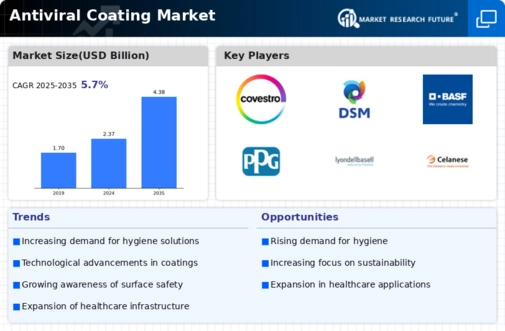Market Growth Projections
The Global Antiviral Coating Market Industry is on a growth trajectory, with projections indicating a market value of 2.37 USD Billion in 2024 and an anticipated increase to 4.38 USD Billion by 2035. This growth reflects a compound annual growth rate (CAGR) of 5.73% from 2025 to 2035. Such figures suggest a robust demand for antiviral coatings across various applications, driven by factors such as technological advancements, regulatory support, and heightened awareness of hygiene. The market's expansion is likely to create opportunities for manufacturers and innovators in the field, fostering a competitive landscape.
Expansion of End-User Industries
The expansion of end-user industries, including healthcare, automotive, and consumer goods, is a key driver of the Global Antiviral Coating Market Industry. As these sectors grow, the demand for antiviral coatings is likely to increase correspondingly. For instance, the automotive industry is exploring the application of antiviral coatings on vehicle interiors to enhance passenger safety. This trend is indicative of a broader movement towards integrating health-conscious materials into various products. With a projected CAGR of 5.73% from 2025 to 2035, the market is poised for sustained growth as more industries recognize the value of antiviral coatings.
Rising Demand for Hygiene Solutions
The Global Antiviral Coating Market Industry experiences a notable increase in demand for hygiene solutions across various sectors, including healthcare, transportation, and public spaces. This trend is driven by heightened awareness of infection control and the need for protective measures. For instance, hospitals are increasingly adopting antiviral coatings on surfaces to reduce pathogen transmission. The market is projected to reach 2.37 USD Billion in 2024, reflecting a growing commitment to maintaining sanitary environments. This demand is likely to continue as organizations prioritize health and safety, thereby propelling the growth of the Global Antiviral Coating Market Industry.
Government Initiatives and Regulations
Government initiatives aimed at promoting public health and safety play a crucial role in shaping the Global Antiviral Coating Market Industry. Regulatory bodies are increasingly mandating the use of antiviral coatings in specific environments, such as hospitals and schools, to mitigate the spread of infectious diseases. These regulations often encourage manufacturers to innovate and improve their product offerings. As a result, the market is likely to benefit from increased compliance and adoption rates. This regulatory landscape not only supports the growth of the industry but also enhances consumer confidence in antiviral solutions.
Growing Awareness of Surface Contamination
The Global Antiviral Coating Market Industry is significantly influenced by the growing awareness of surface contamination and its role in disease transmission. Educational campaigns and research findings have highlighted the importance of maintaining clean surfaces, particularly in public and shared spaces. This awareness drives demand for antiviral coatings that can provide an additional layer of protection. Industries such as hospitality and retail are increasingly investing in these solutions to reassure customers and employees alike. The market's growth trajectory is expected to align with the rising recognition of the importance of surface hygiene.
Technological Advancements in Coating Materials
Innovations in coating technologies significantly influence the Global Antiviral Coating Market Industry. The development of advanced materials, such as nanotechnology-based coatings, enhances the efficacy and durability of antiviral properties. These advancements allow for longer-lasting protection against viruses on surfaces, which is particularly beneficial in high-traffic areas. For example, coatings that incorporate silver nanoparticles have shown promising results in inhibiting viral activity. As these technologies evolve, they are expected to attract investments and drive market growth, contributing to an anticipated market value of 4.38 USD Billion by 2035.











